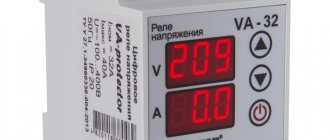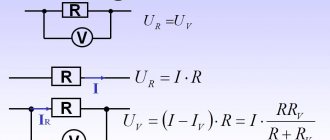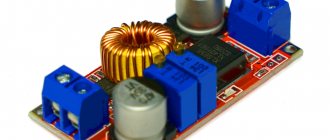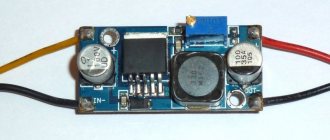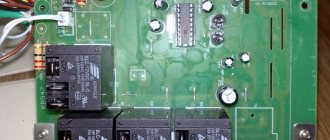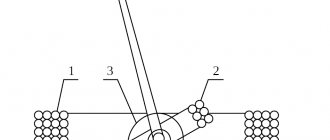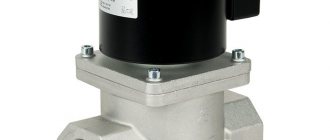The demand for high-quality voltage stabilizers is only growing every year, which is explained by the increased number of household consumers, as well as a decrease in the quality of the network product. The domestic market offers a large selection of inexpensive and reliable models of stabilizing units that guarantee the consumer normal power supply. Before going to the store to make a purchase, it is advisable to understand the features of these devices, as well as familiarize yourself with how to choose them correctly.
Purpose of voltage stabilizers
Voltage stabilizer Resanta ASN-3000/3
The main purpose of the units is to provide the consumer with stabilized voltage, allowing it to be used to operate household appliances in the house. These devices are necessary to improve the quality of electricity supplied to consumers, which has deteriorated significantly in recent years.
This concerns not only the amplitude of the voltage transmitted through the network, but also its shape, as well as the magnitude of nonlinear distortions (deviations from a sinusoid).
All of the listed characteristics can be corrected by converting low-quality voltage and then bringing it to normal.
For this purpose, the device includes mechanical, electromechanical or electronic components responsible for adjusting the output sinusoid. A 220 V voltage stabilizer designed for single-phase power supply is optimal for home use and office use. If you have this converting device, you don’t have to worry about the safety of the radio equipment and other household appliances connected to it.
Main characteristics of the device
The main characteristic of electromechanical stabilizers is the amount of active power. The power of the household EMC model ranges from 5-7 kW. There are more powerful devices in which this figure reaches 22 kW.
An important indicator is the stabilization range. This is the voltage value between the low value and the highest voltage threshold where the device can perform its function. The best EMC models operate between 130 and 280 volts.
Other important characteristics include accuracy and stabilization speed. The best indicator of accuracy is deviations within 1.5-3%. As for the reaction speed, the indicator ranges from 5 to 10 v/sec.
Types of stabilizers
According to the type of supply network into which modern mains voltage stabilizers for the home are installed, they are all divided into units designed to operate in 3-phase circuits and their single-phase analogues. In addition, known types of stabilizing devices differ in output power and design, which directly affect the prices stated by manufacturers.
Regardless of all the listed parameters, the basis for the classification of these units is the principle of operation or a typical circuit that allows you to obtain the desired output voltage. According to this feature, the stabilizer models offered on the market are divided into the following main types:
- relay units;
- ferroresonant (parametric) devices;
- electromechanical models;
- semiconductor (thyristor or triac) products;
- inverter or electronic stabilizers.
Each of the listed devices has its own distinctive features associated with the principle of converting the input voltage and the connection circuit used for this. They differ in their appearance (design) and the price declared by the manufacturer of a particular device.
Relay
Relay MV
Classic relay voltage stabilizers belong to the category of electronic devices that operate on the principle of stepwise conversion of the input potential. Their design is based on an autotransformer, the output windings of which are switched in such a way as to correct fluctuations in the network.
Changing the number of turns in the secondary winding occurs automatically due to the operation of built-in switching devices - electromagnetic relays.
A special unit, which experts call a control unit, is responsible for the order of switching relay elements. With its help, it is possible to control the parameters of the mains voltage and, if deviations from the norm are detected, put into operation the next stage of stabilization (corresponding to the number of e/m relays).
The main advantage of relay devices, when compared with outdated compensation-type models, is the high speed of operation of the stages (about 10-20 ms). In addition, such control modules are quite simple, which greatly facilitates maintenance and repair of the finished product.
The disadvantages of relay machines include insufficiently smooth adjustment of the output potential and a low working life. Many users are annoyed that this unit constantly clicks during operation (due to switching relays). The main area of application is low-power equipment connected to networks with low input power instability.
Ferroresonant
This type of stabilizer refers to samples that appeared at the initial stage of development of converter devices. The beginning of their mass introduction into everyday life in the 50-60s of the last century was explained by the need to protect the then fashionable tube televisions. The principle of their operation is based on the use of the ferromagnetic resonance effect, the essence of which is the electromagnetic interaction of two chokes (coils with cores). It is especially important that one of them works in saturated mode, and the other in unsaturated mode.
The advantages of ferroresonant stabilizers include the absence of moving (switchable) catches, and as a result - a low probability of failure and a longer working life than relay devices. In addition, with their help it is possible to achieve more accurate setting of the output voltage and smooth adjustment. Their disadvantages are as follows:
- noise during operation;
- significant heat generation;
- bulkiness (large dimensions);
- small range of adjustable voltages.
Despite these disadvantages, ferroresonant stabilizers still enjoy some popularity among consumers. Their area of application is the protection of old household appliances that are unpretentious in handling.
Electromechanical
Electromechanical voltage stabilizer
Devices of this class appeared on the electrical products market at approximately the same time as their ferroresonant analogues, although they differed significantly from them in their design and operating principle. Their main working unit is an autotransformer with a movable current-collecting contact placed on it.
The adjusting element is made in the form of a slider or a removable brush of a special design. When the device operates, it moves along the transformer winding, smoothly increasing or decreasing the conversion coefficient, which allows you to effectively adjust the input voltage.
The first samples of electromechanical devices had manual adjustment - the movement of the slider along the windings of the autotransformer was assigned to a person. In modern models, this process is automated through the use of a special control module.
Their advantages and disadvantages are the same as those of ferroresonant samples, and their area of application is devices that do not require high speed.
Inverter (stepless, transformerless, IGBT, PWM)
Inverter MV
This type of regulator belongs to the family of modern stabilizers with advanced technology, produced since the beginning of the century. The operation of the devices is based on the principle of double conversion of the original voltage, thanks to which it is possible to generate a signal of the desired shape and amplitude at the output. Since modern pulse units do not have mechanical or electromechanical components, they operate completely silently, have high performance, and are not inferior in reliability to any of the known models.
The advantages of these devices also include:
- expanded boundaries of smooth adjustment of mains voltage and current in the load (90-310 Volts);
- the presence of filter modules at the input and output of the device that suppress network interference;
- compactness and light weight.
The only drawback of standard inverter converters is their high cost.
Electronic (triac, thyristor)
The design and principle of operation of electronic units is somewhat similar to relay-type devices. But instead of relays, semiconductor switches are used here, built on the basis of valve elements (thyristors or triacs).
There are also varieties of units on sale in which the function of switching keys is performed by semiconductor transistors.
Due to the use of electronic components, these devices operate absolutely silently.
Other advantages of inverter circuits and devices include:
- high speed and absence of mechanical components;
- durability and reliability of the semiconductor parts included in their composition;
- wide voltage regulation limits;
- temperature stability and high efficiency, which is explained by the efficiency of the elements included in the circuit (including field-effect transistors, which consume practically no current).
Their disadvantage is the same as that of relay analogues - this is explained by the discrete nature of output voltage control.
Device diagram and main features
The main feature of the electromechanical stabilizer is the regulation of the incoming current by a slide contactor. The slider moves along the surface of the coil, thereby changing the number of working turns of the transformer winding. The current collector is driven by a stepper motor.
The winding of a toroidal transformer is covered with insulated wire. Insulation has been removed from the work area. The stepper electric motor turns the current collector exactly at a certain angle specified by the electrical circuit of the device. Below are 2 EMC electronic circuits.
Operational amplifier circuit
EMC with relay electric drive
Selection rules
Before deciding on the choice of a stabilizer based on the type of power supply, it is important to decide in which networks it is intended to be used. If you plan to use it in an apartment in a city house, the owner will need a standard single-phase device. If the buyer intends to use it at the dacha, where there is a 380 Volt power supply, only a three-phase sample will do.
Before going to the store, it is important to familiarize yourself with the manufacturers of these devices and choose a company that has a good reputation. In this case, it does not matter whether it is a domestic or foreign company, since our manufacturers are also capable of making competitive models.
Ferroresonant
The operating principle of such SVs is based on the effect of voltage ferroresonance in the capacitor-transformer circuit. This type of protective devices is not very popular among consumers due to noise during operation, large dimensions (and, accordingly, significant weight), and the inability to operate under overloads. The advantages of ferroresonance stabilizers are their long service life, accuracy of adjustment and the ability to work in rooms with high humidity/temperature.
Model overview
The easiest way to review modern stabilizers for the home is to focus on the advantages and disadvantages of several branded samples. For this purpose, models were selected representing such competing ones as “Energy”, the domestic development “Shtil”, as well as a brand called Sven.
The rating of stabilizers for the home is headed by a model from, which produces products with an excellent price-quality ratio. The devices of this company are capable of operating with loads of various sizes (power from tens to hundreds of watts). The Resanta assortment includes many single-phase relay-type models, but samples with double voltage conversion (inverters) are also often found. This brand has practically no disadvantages (except for the price).
The second position in the ranking is occupied by Energia, a diversified company that has only recently mastered the production of high-quality stabilizers. All models of this manufacturer are distinguished by a proven quality-price ratio and are in constant demand among Russian consumers. Their advantages also include a wide selection of different designs.
Next comes , which produces budget products and mid-price models, as well as premium samples. Especially popular are electronic inverters, which are not inferior in their capabilities to modern uninterruptible power supplies.
The last on this list is the Finnish company Sven, whose products are suitable for both home and office use. Prices for products from Finland are quite affordable for the average user with consistently high quality. According to the manufacturer, the service life of all manufactured models is on average at least 10 years.
Electronic
Electronic MVs can be triac and thyristor. The operating principle of the former is based on switching between the windings of an autotransformer using a triac, due to which this type of voltage stabilizer has high efficiency and a fast response to operation. In addition, triac models operate silently, which is another advantage of this type of SV. As for thyristor ones, they have also proven themselves well and are popular in everyday life. The only drawback of electronic devices is their higher cost.
Voltage stabilizers for summer cottages
At dachas, special models of stabilizers are traditionally in demand, which can be connected directly to the input panel through a separate machine. They are distinguished by a relatively high conversion power, since they are used to work with specific country equipment (pumps, watering systems, etc.). These devices can be connected to the stabilizer using a special distribution block or through the socket provided in some models.
At the dacha, it is necessary to have grounding, through which it is possible to ensure safe work with garden equipment.
In the open air, not only the metal parts of the units used are reliably grounded, but also the housing of the stabilizer itself, installed in a linear circuit.
When choosing a stabilizing device intended for a home or summer cottage, it is based on the calculation of the permissible power in the serviced load. Therefore, when evaluating various models for this parameter, it is selected with a small margin (about 10-15 percent).
In what cases will the use of electromechanics still be appropriate?
The use of servo drive devices seems quite justified in everyday life at low consumption loads in networks with small voltage drops.
Many users, especially those who have dachas, are probably well aware of the state of rural, dacha or even urban power grids in the private residential sector and in practice have more than once encountered poor-quality power supply. Therefore, the use of electromechanics is in great demand in everyday life - as a relatively effective and inexpensive solution.
Considering the nature of the connected load, we can safely recommend them for stabilizing the output voltage in lighting networks. The smoothness of stabilization completely eliminates or partially smoothes out changes in mains voltage, making jumps in light emitted by lamps less noticeable and irritating to the eyes. To be fair, we note that this only applies to lamps with incandescent and halogen lamps. Of course, there will be no such effect with gas-discharge lighting devices that work with ballasts, or with LED lamps that are becoming increasingly popular.
Final tips
If, having read this section of the article, you have not decided on your choice, then here are the parameters from stabexert.ru that should be taken into account when choosing a specific stabilizer.
Device power
This is the first thing you should pay attention to, regardless of the type of device you choose. To determine the required power of the stabilizer, it is necessary to sum up the electrical load of all electrical appliances whose voltage is supposed to be stabilized. The power value is usually indicated in the passport of the electrical appliance, and, as a rule, on the nameplate attached to it. The power of the lighting lamp is indicated on its base. It is better if the power of the stabilizer exceeds the installed power of electrical appliances by 20 - 30 percent. This will protect the device from overloads and extend its service life.
When assessing power, one circumstance should be taken into account. There is the concept of total, active and reactive power. First of all, we are interested in the active component, measured in watts
, the value of which is most often indicated on the electrical appliance. However, some stabilizer manufacturers may indicate the full power of their products, which is measured in volt-amperes (VA). In order not to go into theory again, to obtain the active power value, in this case you can multiply the total power value by 0.9. The bulk of the load of household consumers is active. Electric motors and fluorescent lighting have a reactive component.
Useful: use our calculator to calculate power.
Stabilizer type
This choice is based on an assessment of the main characteristics of the types of devices under consideration and the characteristics of the local power supply system. Comparing the parameters of stabilizers of various types, you can see that while winning in one quality, the device is often inferior in other qualities to stabilizers of another type. In this case, the decisive factor in the choice should be an analysis of the power supply parameters.
For example, in areas characterized by stable long-term deviations of the supply voltage level in one direction or another, it is logical to choose stabilizers with a smooth control system with a servo drive, as they have the highest stabilization accuracy. In the same situation, but with supply voltage deviations over a very wide range, a hybrid type stabilizer will help save the situation. If the power supply is accompanied by very frequent and sharp surges in the voltage level, relay or electronic type stabilizers will provide more reliable protection.
As for inverter-type devices, according to the characteristics declared by the manufacturers, they are universal. The main question from a technical point of view is how close to a sine wave the actual voltage curve produced by these devices is. The complaint about these devices from an economic point of view is that they are the most expensive so far.
About reliability
And more about reliability issues. By saying that electronic devices devoid of mechanical contacts and moving parts have higher reliability, we are only setting out a general theoretical concept. In practice, the reliability of electronic devices depends on how successful the circuit design itself is, where each component used must operate within acceptable parameters and have the appropriate workmanship. New devices that have not been tested over long-term operation suffer a particularly high rate of failures. Therefore, situations are not uncommon when good old mechanical devices turn out to be more reliable than new electronic systems. Of course, this should not be taken as a mandatory rule; these phenomena are more likely related to growing pains. The future, of course, belongs to electronic and microprocessor technology, the functionality and reliability of which is constantly growing.
On this topic:
Which voltage stabilizers are the most reliable >>>
